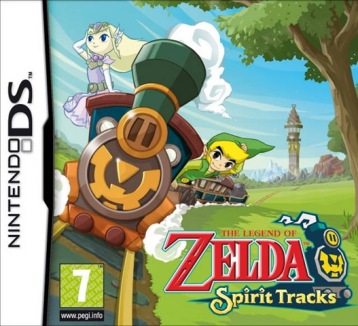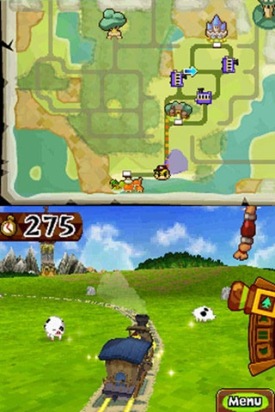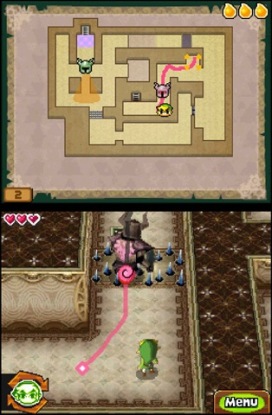When The Legend of Zelda made its touch screen debut with The Legend of Zelda: Phantom Hourglass, there was some initial confusion as to why they decided to make a direct sequel. This confusion only escalated when the art style and sailing aspects were returning considering the serious looking Wii launch title The Legend of Zelda: Twilight Princess. It met with decent reception upon release, but was criticised for having repetitive segments and unrefined graphics. The market was definitely there for a follow up. So, the train approaching platform 3 is The Legend of Zelda: Spirit Tracks. Does the train serve up a first class service or will it simply derail into a burning heap?
If you were hoping that this would in no way resemble the cell shaded Zelda games of the past, then you’ll be sadly disappointed. Not only does the game feature the same artistic style, but it is yet another sequel to that story arch. Set roughly a hundred years after the events of The Legend of Zelda: Phantom Hourglass, it seems the waters have subsided and the land is green once more. Link has just finished training as a train engineer (bear with me on this one), and goes to Hyrule in order to receive his qualification. Upon his meeting, Zelda slips him a note asking him to help her as she suspects Chancellor Cole is up to something. As they slip away from the castle town, the train crashes and chancellor Cole reveals his true colours. In a bizarre twist of fate, he steals Zelda’s body to use as a host for a demon he is attempting to resurrect. Two important things come from this. The first is that this is a fairly typical plot in essence, but the players are of different origins. The second and perhaps most important thing, is that this time Zelda is coming along for the ride. Considering for years we’ve had to put up with annoying spirits and men who want to be fairies, having royalty as the passenger is a refreshing concept. While a lot may seem familiar, there are subtle differences and they’re definitely welcome.
Another similarity between the two DS titles is the control method. It is almost entirely touch screen enabled as tapping on a certain spot will allow Link to move there. Drawing a line or tapping an enemy will make him attack, while circles perform his trademark spinning attack. Some minor tweaks have been made to this, as rolling has been made more difficult to perform, but they generally work well. New train segments may seem limiting at first, but the expanse of map coverage expands greatly as you chug along the story. Enemies are slightly harder to deal with here as the cannon doesn’t seem to want to shoot exactly where you want it to, despite endless readjusting of the accuracy of the stylus input on the DS dashboard. Input of destination is far easier due to the linear tracks instead of vast oceans. Another big addition is the inclusion of the Spirit Flute. Much like the Ocarina of Time and Wind Baton, it is used to play melodies to trigger events or get through plot elements. Here it is used by dragging the bottom screen to focus on the note you want and then blowing, literally. It might make you look like an idiot on the train, but it generally works well.
The majority of the time spent in this game will be either doing side-quests, traversing to the higher levels of the spirit tower and of course, dungeons. Everything moves along in a set pattern, with new diversions making themselves known as you progress through the adventure. A depressing statistic is that the game only features five dungeons overall. Considering the majority of Zelda games have eight, this may seem like daylight robbery. The spirit tower however is several dungeons in itself, and makes up for this numbers hassle. One thing that has drastically changed from the Phantom Hourglass hub dungeon is the absence of a timer. Not having to worry about time limits and more time spent on exploration is welcome. Then there’s another series first. Zelda actually does something helpful. Remember the Phantoms that stalk the corridors like some crazy janitor hunting rats? She can possess them. Having a sidekick who is beefier than a Spanish Bull on “Lets run over humans” day makes this a more fun experience. Puzzles are intuitive, with some rather unethical solutions and the boss battles approach the same level of detail as console counterparts. While this may seem like an easy Zelda game, there is a lot to do and even more track to cover.
There is also a multiplayer component which requires only a single cartridge to run. Many copies of Link must collect as many pieces of the Triforce as is possible before either the time runs out or you get clobbered by the wandering Phantom. This sounds like a good time waster, but there is a trade-off. It only has a local mode, which considering Phantom Hourglass has an online multiplayer mode is a little suspect. Thankfully, the single player experience is so complete in its content that the multiplayer snafu hasn’t damaged the overall package.
Visually, it doesn’t seem all too different from the other DS Zelda adventure as it still doesn’t push a lot of the hardware and still has some ugly textures. But looking from a more artistic point of view there is a sense of ironic subtext woven into the overall look and feel of the game. While the new features have an industrial age twist, the artistic design seems more tribal with lush colours and tipi like huts. The music seems to join in on this ironic statement against industrialism with pan-pipe melodies that are not only catchy but amongst the best of the Zelda series music to have surfaced in quite a while. There are occasions where the sound processor doesn’t quite manage to keep everything from turning into a momentary reverb bonanza, but the effect everything is going for is so inspired that it is alright to forgive some hardware shortcomings.
The Legend of Zelda: Spirit Tracks successfully brings a new set of twists to the almost tired out series. Sure every Zelda game has been a smash hit due to excellent dungeons, but few stand out in the crowd as solid works. This is certainly no Ocarina of Time or Wind Waker, but to even mention one of the handheld Zelda’s in the same sentence as both of those games without uttering the words “pales in comparison” is an achievement in itself. While this is partially due to the referenced material from the title, the majority of the success comes from the feel and look of the game. It’s not stunning by any means, but it is certainly as pleasant as a steamy hot bath with soapy suds while getting your back washed by a beautiful servant. So is this better than The Legend of Zelda: Phantom Hourglass? Well, while that sank to the deep abyss of the forgotten, Spirit Tracks steams on ahead in rejuvenating a modern classic.



